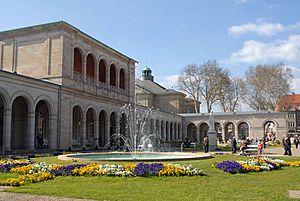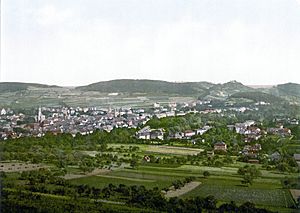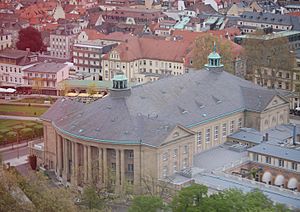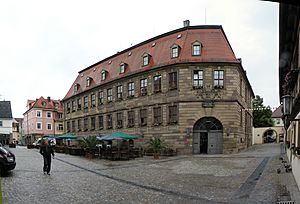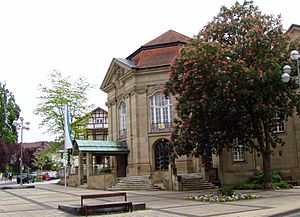Bad Kissingen facts for kids
Quick facts for kids
Bad Kissingen
|
||
|---|---|---|
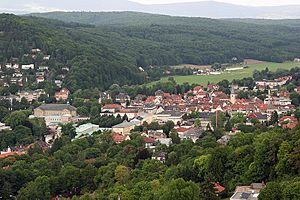
Bad Kissingen viewed from Bodenlaube ruins
|
||
|
||
|
Location of Bad Kissingen within Bad Kissingen district
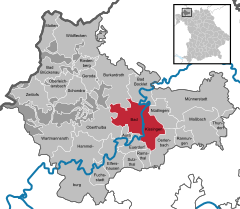 |
||
| Lua error in Module:Location_map at line 530: Unable to find the specified location map definition: "Module:Location map/data/Germany Bayern" does not exist. | ||
| Country | Germany | |
| State | Bavaria | |
| Admin. region | Unterfranken | |
| District | Bad Kissingen | |
| Subdivisions | 9 Stadtteile | |
| Area | ||
| • Total | 69.42 km2 (26.80 sq mi) | |
| Elevation | 220 m (720 ft) | |
| Population
(2022-12-31)
|
||
| • Total | 23,037 | |
| • Density | 331.850/km2 (859.49/sq mi) | |
| Time zone | UTC+01:00 (CET) | |
| • Summer (DST) | UTC+02:00 (CEST) | |
| Postal codes |
97688
|
|
| Dialling codes | 0971 | |
| Vehicle registration | KG | |
| Website | www.badkissingen.de | |
| UNESCO World Heritage Site | ||
| Part of | The Great Spa Towns of Europe | |
| Criteria | Cultural: (ii)(iii) | |
| Inscription | 2021 (45th Session) | |
Bad Kissingen is a famous spa town in Bavaria, a region in Germany. It is located in Lower Franconia, south of the Rhön Mountains, right by the Franconian Saale river. For a long time, Bad Kissingen has been known as a "Weltbad," which means a world-class health resort.
In 2021, Bad Kissingen became part of a special UNESCO World Heritage Site called "Great Spa Towns of Europe." This happened because of its amazing mineral springs and beautiful buildings. These buildings show how popular spa resorts were in Europe from the 1700s to the 1900s.
Contents
History of Bad Kissingen
Bad Kissingen was first mentioned in history in the year 801. Back then, it was called chizzicha. People knew about its special mineral springs as early as 823. For a while, the town was controlled by Fulda Abbey, then by the Counts of Henneberg. In the 1300s, it was sold to the bishops of Würzburg.
Kissingen was first called a "town" in 1279. It started to become a spa in the 1500s, and its first official spa guest visited in 1520. In 1814, Kissingen became part of Bavaria. The town grew into a very popular resort in the 1800s. Ludwig I of Bavaria helped to expand it.
Many important people visited the spa during this time. These included Empress Elisabeth of Austria, Tsar Alexander II of Russia, and King Ludwig II of Bavaria. King Ludwig II even added "Bad" to the town's name in 1883, which means "bath" or "spa" in German. Other famous visitors were the writer Leo Tolstoy, the composer Gioachino Rossini, and the artist Adolph von Menzel.
On July 10, 1866, a big battle happened in Kissingen. This was during the Austro-Prussian War. Bavarian and Prussian soldiers fought here, and the Prussians won.
Otto von Bismarck, a very important German leader, visited Bad Kissingen's spas many times. In 1874, someone tried to harm him in the town, but he was safe. In 1877, he wrote down his ideas for Germany's foreign policy here. This was called the Kissingen Dictation. Today, Bismarck's old home in Bad Kissingen is a museum.
In 1911, important talks about Morocco happened in Bad Kissingen. German and French leaders met, but they could not agree. This led to the Agadir Crisis.
In the 1900s, more regular people started visiting the spa instead of just royalty. The spa had to close for one year in 1945, which was the only time in its history.
Before World War II, the German military built barracks in Bad Kissingen. In 1945, the American army came into the town peacefully and took over these barracks. They were later named Daley Barracks. These barracks closed in the 1990s when American troops left after the Iron Curtain fell.
After the war, new health clinics were built in the town. Later, changes in health laws made it harder for people to get their spa visits paid for by insurance. This caused some job losses. So, the town worked hard to attract new visitors. An important survey even named Bad Kissingen Germany's most famous spa town!
In 2015, about 1.5 million overnight stays were recorded, with over 238,000 visitors. In 2004, the KissSalis Therme opened, which is a fun spa and leisure center. Also in 2004, a German-Chinese Football Academy opened. The Chinese "08 Star Team" trained there for the 2008 Olympic Games in Beijing.
What Makes it a Spa Town?
Bad Kissingen has 7 special mineral springs, and people still use them today. Most of these springs are cold and have lots of sodium, carbonates, and sulphates. The water gets these minerals from old rock layers deep underground.
Bad Kissingen was one of the top spa towns in the 1800s and early 1900s. These special "Weltbad" (world-class spa) towns had a few key features:
- Fun and Entertainment: Social life was just as important as the health treatments. A "Weltbad" offered many ways to have fun, like sports, trips, theater, concerts, libraries, and games.
- Guests from Everywhere: People from all over the world visited these spas. Famous visitors, especially kings, queens, and wealthy people, helped attract even more guests.
- Beautiful Buildings: These towns had special areas with spa buildings, fancy villas, shops, and lovely gardens and parks that blended into the natural surroundings.
- Modern Services: Even though they weren't huge cities, "Weltbad" towns had all the latest comforts. This included good ways to travel, modern communication (like telegraphs and telephones), luxury shops, great hotels and restaurants, and advanced systems for power, water, and waste.
Geography
Town Areas
Bad Kissingen is made up of its main town and several smaller areas, called districts. Here are the districts and how many people lived in them as of January 1, 2011:
- Albertshausen (624 people)
- Arnshausen (1,244 people)
- Bad Kissingen (11,003 people)
- Garitz (4,557 people)
- Hausen (1,704 people)
- Kleinbrach (375 people)
- Poppenroth (876 people)
- Reiterswiesen (2,103 people)
- Winkels (1,378 people)
Climate
| Climate data for Bad Kissingen (1991–2020 normals) | |||||||||||||
|---|---|---|---|---|---|---|---|---|---|---|---|---|---|
| Month | Jan | Feb | Mar | Apr | May | Jun | Jul | Aug | Sep | Oct | Nov | Dec | Year |
| Mean daily maximum °C (°F) | 3.3 (37.9) |
5.0 (41.0) |
9.9 (49.8) |
15.3 (59.5) |
19.4 (66.9) |
22.7 (72.9) |
25.0 (77.0) |
24.7 (76.5) |
19.7 (67.5) |
13.6 (56.5) |
7.3 (45.1) |
3.8 (38.8) |
14.1 (57.4) |
| Daily mean °C (°F) | 0.7 (33.3) |
1.5 (34.7) |
5.1 (41.2) |
9.5 (49.1) |
13.5 (56.3) |
16.8 (62.2) |
18.7 (65.7) |
18.2 (64.8) |
13.8 (56.8) |
9.1 (48.4) |
4.5 (40.1) |
1.5 (34.7) |
9.4 (48.9) |
| Mean daily minimum °C (°F) | −1.9 (28.6) |
−1.8 (28.8) |
0.8 (33.4) |
3.9 (39.0) |
7.7 (45.9) |
11.0 (51.8) |
12.9 (55.2) |
12.5 (54.5) |
8.9 (48.0) |
5.4 (41.7) |
2.0 (35.6) |
−0.8 (30.6) |
5.1 (41.2) |
| Average precipitation mm (inches) | 59.5 (2.34) |
45.0 (1.77) |
45.1 (1.78) |
34.2 (1.35) |
60.6 (2.39) |
58.7 (2.31) |
76.6 (3.02) |
59.2 (2.33) |
49.3 (1.94) |
53.3 (2.10) |
56.9 (2.24) |
68.7 (2.70) |
665.8 (26.21) |
| Average precipitation days (≥ 1.0 mm) | 16.4 | 13.8 | 14.1 | 11.9 | 13.4 | 14.0 | 14.5 | 13.5 | 12.1 | 15.3 | 16.5 | 18.1 | 173.1 |
| Average snowy days (≥ 1.0 cm) | 9.8 | 6.7 | 2.3 | 0.1 | 0 | 0 | 0 | 0 | 0 | 0 | 1.3 | 5.2 | 25.4 |
| Average relative humidity (%) | 85.4 | 81.3 | 75.0 | 67.8 | 70.7 | 70.9 | 70.8 | 72.2 | 78.6 | 85.7 | 88.9 | 88.5 | 78.0 |
| Mean monthly sunshine hours | 42.0 | 70.7 | 121.4 | 176.8 | 204.2 | 217.2 | 226.5 | 209.2 | 148.9 | 92.2 | 39.6 | 28.6 | 1,590.8 |
| Source: World Meteorological Organization | |||||||||||||
How Bad Kissingen is Governed
Mayors of Bad Kissingen
Here are the people who have been the mayor of Bad Kissingen:
- Franz Meinow (1945–1946)
- Franz Rothmund (1946–1947)
- Karl Fuchs (1947–1952)
- Hans Weiß (1952–1984)
- Georg Straus (1984–1990)
- Christian Zoll (1990–2002)
- Karl Heinz Laudenbach (2002–2008)
- Kay Blankenburg (2008–2020)
- Dirk Vogel (since 2020)
Town Council
The Town Council helps run Bad Kissingen. The current council was chosen on March 15, 2020, and will serve until 2026.
- The mayor, Dirk Vogel, is part of the Social Democratic Party of Germany (SPD).
- 9 members are from the Christian Social Union of Bavaria (CSU).
- 6 members are from the SPD.
- 4 members are from the Demokratische Bürger Kissingen (DBK), a local group.
- 3 members are from the Freie Wähler party.
- 4 members are from the Bürger für Umwelt (BfU) /Alliance 90/The Greens /ödp.
- 2 members are from the Alternative for Germany (AfD).
- 1 member is from The Left Party.
- 1 member is from Zukunft Bad Kissingen, another local group.
In May 2020, some members from the CSU joined the DBK. So now, the CSU has 6 members and the DBK has 7 members on the town council.
Partner Cities
Bad Kissingen has special friendships with these cities:
 Eisenstadt, Austria (since 1978)
Eisenstadt, Austria (since 1978) Massa, Italy (since 1960)
Massa, Italy (since 1960) Vernon, France (since 1960)
Vernon, France (since 1960)
Arts and Culture
Museums
You can learn a lot about history and art in Bad Kissingen's museums:
- Bismarck-Museum: This museum is in the Obere Saline (upper saltworks) and tells you about Otto von Bismarck.
- Jewish Life Exhibition: This permanent exhibit in the old Jewish school shows what Jewish life was like in the past.
- Cardinal-Döpfner-Museum: Located in Hausen, this museum is about Cardinal Döpfner.
Music
Bad Kissingen is a great place for music lovers:
- Kissinger Sommer: This is a famous classical music festival. Well-known orchestras and solo artists from all over the world perform here.
- Kissinger Piano Olympics (Klavierolymp): This is a competition for young piano players, held in autumn. It is connected to the Kissinger Sommer festival.
- Kissinger Winterzauber: Another music festival that takes place every winter.
- German Brass Band Contest: Bad Kissingen hosted this national competition in 2014 and 2016.
Architecture
Bad Kissingen has many interesting old buildings:
- Botenlauben Castle Ruins: These ruins from 1180 look down over Bad Kissingen from a hill.
- Old Town Hall: This building has a beautiful Renaissance design from 1577.
- Current Town Hall: This used to be a fancy house built in 1706 by Johann Dientzenhofer.
- Spa Garden Buildings: Between 1838 and 1913, the arcade (Arkadenbau) was built around the spa garden by Friedrich von Gärtner. Also, the halls for drinking mineral water ("Brunnenhalle") and for walking ("Wandelhalle") were built based on designs by Max Littmann.
- Kurtheater Bad Kissingen: This theater was finished in 1905, also designed by Max Littmann.
- Regentenbau: This concert hall was opened in 1913 and was also designed by Max Littmann.
- Train Station: The train station building was designed by Friedrich Bürklein and built between 1871 and 1874.
Other cool buildings and monuments in Bad Kissingen include:
- Bismarck Monument (Bad Kissingen)
- Bismarck Tower (Bad Kissingen)
- Ludwig Tower (Bad Kissingen)
- Wittelsbacher Tower (Bad Kissingen)
World Cup 2006
During the 2006 World Cup, the Ecuador national football team stayed in Bad Kissingen. The town improved its sports facilities for the team.
Education
- Berufschule Bad Kissingen: This is a vocational school where students learn practical skills for jobs.
Famous People from Bad Kissingen
Many notable people have connections to Bad Kissingen:
- Jeff Baker (born 1981): A baseball player for the Miami Marlins.
- Otto von Botenlauben (1177–1245): A count, poet, and crusader.
- Claus-Frenz Claussen (1939–2022): A doctor specializing in ear, nose, and throat.
- Julius Döpfner (1913–1976): A cardinal and archbishop.
- Sir Dorabji Tata (1859-1932): A key figure in the history of the Tata Group, a big company. He passed away here.
- Trong Hieu (born 1992): The winner of Vietnam Idol in 2015.
- Baptist Hoffmann (1863–1937): An opera singer and voice teacher.
- Cyrill Kistler (1848–1907): A composer, music teacher, and music publisher.
- Henry Kissinger (1923–2023): His great-great-grandfather got his name from Bad Kissingen in 1817.
- Anton Kliegl (1872–1927): The person who invented the Klieg light, a type of stage light.
- Oskar Panizza (1853–1921): A doctor and writer.
- Hanna Ralph (1888–1978): A stage and film actress.
- Jack Steinberger (1921–2020): A physicist and Nobel Prize winner.
Images for kids
See also
 In Spanish: Bad Kissingen para niños
In Spanish: Bad Kissingen para niños



